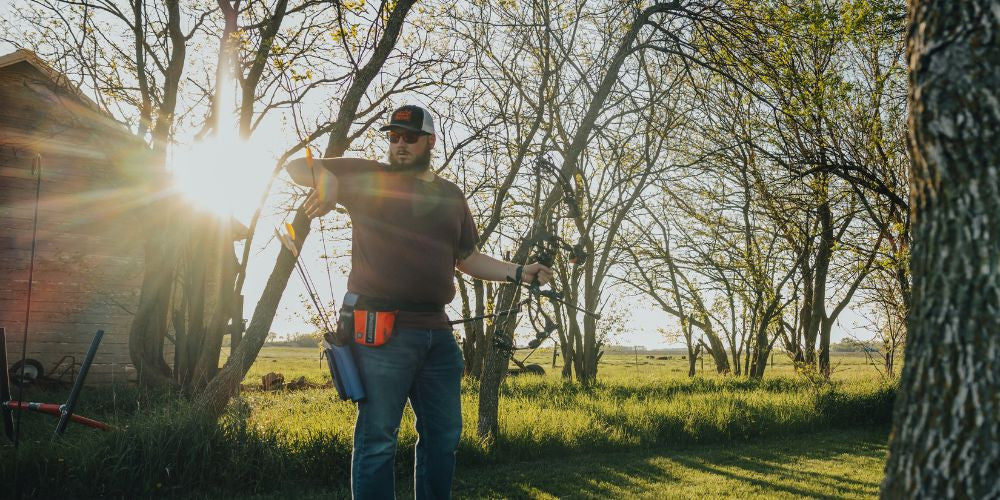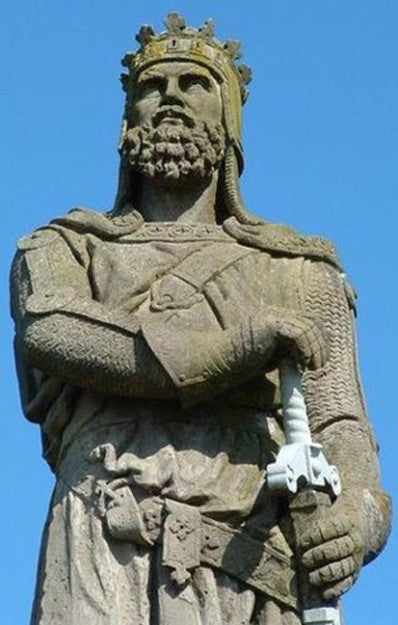I have just been visiting the Scottish town of Glasgow where I stayed with some friends. While I was there, I was also aware of the Commonwealth Archery Championships taking place in Edinburgh. But, unfortunately, I couldn't bring my archery equipment with me. So I had to miss a spot of shooting, so I decided to take the time to learn about the archery that goes on in Scotland. When it comes to Great Britain's archers, the most famous archer that springs to mind is Robin Hood, an outlaw with a bow who lived in hiding in Sherwood Forest in Nottingham. But what about the Celtic nations of Scotland, Wales, Northern Ireland, and the Republic of Ireland? Have they got any famous archers that have any significance in the history of archery in the British Isles?
As it happens, there are. I started my research not by looking for athletes but historical figures. For example, Scottish, Welsh, and Northern Irish archers in the Commonwealth Games may have a strong presence in representing their nations. Still, so far, there's only been one to have won a medal. Janet Yates from Northern Ireland won a silver medal in the Individual woman's recurve match at the 1982 Brisbane Games in Australia. But before we go on into the sports world, I decided to start by looking through Celtic history, and I found one famous character from Scottish history.

Celtic Archers
To many people, William Wallace was a character immortalized by Mel Gibson in the film 'Braveheart' in 1995. Well, like all films, they cannot be trusted to tell a true story. Because there are some things about them that a filmmaker likes to do to make it sell or portray a character in their own artistic right. I've seen plenty of science and history shows that don't really get their facts straight. There is a side to William Wallace that many people don't know about. An episode in his life paints the picture of him as a Scottish Robin Hood. Historical fiction writer Jack Whyte used this as the basis for the book 'The Forest Laird' released in 2011.

The story goes from the start of the uprising against English King Edward I in May 1297, which marked the start of Wallace's crusade against the English. Wallace was living in Lanark, a small town in the central belt of Scotland. It's not known what he was doing there at the time. The history of his personal life is largely vague. However, this incident at Lanark is the first recorded account of Wallace. He had become smitten with and married a girl called Marian Braidfute of Lamington.
The English-appointed sheriff William Heselrig also had his eye on her. Wallace got into a skirmish with Heselrig's men, and Marion helped him to escape. Consumed with raging hatred and revenge, Heselrig killed Marion. When Wallace found out, he returned to Lanark under cover of darkness, armed with a group of followers, and killed the sheriff and his men. Afterward, Wallace and his men retreated into Ettrick Forest. They met up with other Scottish nobles like him, who began to rebel against Edward I used the forest as a base leading into the build-up of the Battle of Stirling Bridge in September of that year.

Now there is no official evidence that Marion actually existed. Still, she has a similarity to Robin Hood's Maid Marion of Sherwood Forest. Some say the chroniclers invented this as well as the love story. Robin Hood was an outlawed nobleman, just like Wallace, and these were very popular tales at the time. Some say that this saga about Wallace's love life may have been invented to make Wallace a Scottish Robin Hood. And there are more suggestions to connect them.
About a month after the famous Battle of Stirling Bridge, a letter arrived in Lubeck, Germany, which contained Wallace's seal, which featured a bow and arrow. The letter was to persuade European traders that Scotland was still open for business despite the war with Edward I. Now, most stories of Wallace as a soldier and a sword-welding knight. But he was actually a trained bow and arrow archer. Some historians believe that Wallace's ability to command a battle like Stirling Bridge suggests that he must have been a soldier disguised amongst Edward's army in the wars in Wales.
Because his seal bear's an archer's insignia, he may have been an archer. If correct, then maybe there is another similarity to Robin Hood. The outlaw from Sherwood Forest was also in the English army, believed to have been fighting for Richard the Lionheart in the Holy Land. It's an interesting theory that these two tales from the heroes of Scotland and England could be related. It's definitely worth making a TV show or a film about the real William Wallace as a bowman.

While the Scots have their own legendary bowmen, you can probably imagine that there are archers with Celtic connections in the rest of the British Isles. There's even a major contribution to the bow and arrow in Wales. The longbow is recognized as an English invention, but that's not entirely true. The origin of the longbow is still disputed. It is thought that the longbow came from Wales.
The longbow was also endorsed by the Welsh, where it is also known as a Welsh longbow. Welsh chronicler and archdeacon of Brecon, Gerald de Barri (also known as Gerald of Wales), describes incredible feats of archery prowess in South Wales in journals he wrote in 1188. 'The people of Gwent, in particular, are more skilled with the bow and arrow than those from other parts of Wales.' He wrote. Gerald also described in his chronicles the incredible feats of Welsh archers in South Wales, revealing in explicit detail the construction of the bows used by the Welsh.
The longbow used by the English was famous for being made of yew, whereas the Welsh made their longbows from elm. These bows didn't look as glamorous as the English longbow, where they were in a rough and unpolished state. During the Anglo-Welsh wars under the reign of the Celtic-hating Edward I, the Welsh archers inflicted heavy losses on the Anglo-Norman invaders. Later, when Edward I triumphed over Wales in 1283, he took Welsh archers into conscription. From there on, the English longbow would evolve from the Welsh longbow.
The Anglo-Normans found that the bowstave of these Welsh longbows were shaped into a flatter, wider D-shape, giving them an advantage over a curved bowstave. With a wide flat shape, the wood's tension and compression strengths could become more balanced as the wider belly of the bowstave has more wood to share the strain.

The English longbow had its finest hour at the Battle of Agincourt in October 1415. Still, it wasn't purely an English tale commanded by Henry V, who unleashed a rain of arrows on the French. The English King's army had around 5000 archers, the vast majority of them from Wales in the village of Llantrisant, northwest of Cardiff. Their bravery won them the town's freedom and credited them with the victory over the French. However, during the battle, there was a moment that made the archers of Agincourt worthy of a mention in what can best be described as one of 'history's rudest inventions.'
The French had a habit of disabling captured archers by cutting off their two first fingers on their drawing hand so they could not shoot a bow. To show their defiance, the English and Welsh archers held up their middle and index fingers at the French to show that they still had their fingers and could take them out. This is where legend has it that the V-sign was invented as an insult to people. It's also frequently referred to as the 'The Longbowman Salute' or 'The Agincourt Salute.' It is frequently used to show contempt, defiance, or disdain.
There are no gallant bowmen from Ireland's archery history to talk about here. Archery in Ireland and Northern Ireland is virtually nowhere to be found in folklore or legends from even the bronze age and iron age periods. The famous English outlaw Robin Hood has a very sketchy past.
Some stories claim that he is fictional, and some claim he was around in real life. Still, his existence is believed to be from a combination of different historical figures. Now, if that is a great persona for an archery hero, then I think it is okay for us to accept archers from the great works of fiction in literature, TV shows, and films.
Let's take a look at Princess Merida from the film "Brave." She was a strong, feisty woman determined to control her own destiny. One of the most skilled archers in the kingdom, Merida is skilled in many combat sports that she plays on the countryside. She learned these skills from her father, who expects her to find a husband and become a formal royal princess, which she defies. Next, let's move to Celtic archers on TV.
The closest we can find is from HBO's award-winning fantasy drama 'Games of Thrones, which is mainly shot in Belfast, Northern Ireland. This is probably the closest archery recognized famously in Ireland. The power and violence themes of this hit TV saga use archery to bring the excitement of historical fiction.
I haven't seen the entire Game of Thrones series myself, but I have seen quite a few clips online. For me, those US TV shows with their 20+ episodic TV shows go on for so long that you end up becoming a couch junkie. I'd rather be out playing with my bow and arrow shooting, not lazing in front of the TV. However, I will consider buying a box set sometime in the future. At least four archers featured in Games of Thrones: Theon Greyjoy, Anguy, Ygritte, and Arya Stark.
All of them have their own unique character and skills with a bow. They bring archery to the fore in a strong but violent manner. The impact of Game of Thrones on archery has also led to an increased interest in archery in Northern Ireland. There is a Game of Thrones inspired attraction in County Down called the Winterfell Tours Archery Experience, where you can live and dress up as Game of Thrones characters, all the while practicing with a longbow and experiencing the thrill of shooting arrows.

Now I think it's worthwhile to take a look at the Scottish, Welsh, and Northern Irish archers we see as athletes. At the time of writing, the Senior Commonwealth Championships (Euronations) took place in Edinburgh. This event started in 1997 and is run by an organization made up of Commonwealth Archery countries to help promote archery to become a core sport in the Commonwealth Games, just like what I am trying to achieve with my own campaign via change.org. The Scottish team won this time around, and I am pleased to say that I have at least found some Scottish archers who tend to be seen as hidden champions of Team Scotland. The same can also be said of Wales and Northern Ireland. I don't think archery in the UK should be recognized as entirely English.
The most significant achievement by an archer from the British Isles other than England is when Northern Ireland's Janet Yates came second in the individual woman's round at the 1982 Commonwealth Games in Brisbane. That was an extraordinary feat, but that isn't the only example. In New Delhi 2010, some great archers played well for Scotland, Wales, and Northern Ireland. You can also find some suburb shooters in the national archery associations of these nations to find some shocking best-kept secrets. This can be very useful if you want to know what other fantastic sportspeople Britain offers to unleash on the world stage to grab the glory when you need it most.



If I had to nominate some of them to watch out for, I have some personal favorites. Scotland has Tim Keppie from Perth, one of Team Scotland's compound archers for New Delhi 2010. A champion who is a regular on the European Professional Archery series, a commercially run enterprise that promotes some of the most challenging archery courses in Europe.
Another Commonwealth Scottish archer is Alastair Whittingham from Edinburgh, a top performance coach at Edinburgh University who advertises his services on performance-archery.com. Also from Edinburgh, there's recurve archer Claudine Jennings, another Commonwealth champion who is currently a team manager for Team Scotland's youth archers due to be seen in action at the Commonwealth Youth Games in Samoa.
You can also find her as director of performance at Scottish Archery. One notable Scot with an impressive history is Simon Needham from Montrose. He was on Team GB's archery squad at the 2000 Sydney Olympics and has written several archery instruction books. Last but not least is Aberdeen's Emma Downie, the top Scottish archer of the New Delhi squad. Emma is the most highly decorated female Scottish archer and currently trains at Archery GB's HQ in Lilleshall.


Moving onto the Welsh archery community, there are some fine sharpshooters, some of whom I've seen in action at a Double FITA World Record status shoot. One of them was Dave Phillips from Cwmbran, who recently came out of retirement from archery after a 30-year absence and is currently among the BBC's 'one to watch for Rio 2016'. He quickly rose up the ranks in the para recurve category and is now a para European Games and British National champion. That is not bad for someone who just got back in the game in a short time.
Two of Wale's finest that make Commonwealth champions are the Howells sisters: Jan and Jeanette from Pontypridd. Both of them shoot compound and are well-established field and target champions. Wales's most recent successful archer is their current number one, Clare Harris from Maidenwells. She is about to shoot for Team GB at the World Archery Championships in Copenhagen, Denmark. There is also a potential future Olympian to watch out for called Ryan Pinder, a junior national and Commonwealth junior champion.


Northern Ireland's success with archery hasn't stopped with Janet Yates's silver-winning triumph at Brisbane in 1982. There are some potential archers to look out for on the world stage here. Junior champion of World Archery Jordan Mitchell from Larne recently shot for the Team GB squad at the World University Games. Another prospective Rio 2016 archer is Belfast's Patrick Huston, who is currently a World Archery youth champion.
Ballyvalley girl Rebecca Lennon is a World Archery youth champion compound shooter. She would make a good candidate for a future Commonwealth Games, where archery will be a core sport. While looking up these fine archers, I noticed some of them had put my petition on their Facebook pages. With their support and my efforts, I hope to see them at future games and thank them for helping in the campaign. I can count on their support, and I am glad to see it from two of Bangor's sibling shooters, Stuart and Darrel Wilson.
Both these record-breaking Irish champions were on the team at New Delhi in 2010. So too, was Mark Nesbitt from Banbridge, one of Northern Ireland's golden boys who has broken several records for his country. He's an Olympic Youth medallist for Team GB and has now matured into a senior archer. Will we be seeing him again shooting for Northern Ireland at the Commonwealth Games, I certainly hope so. The talent and level of archery in these three Celtic nations are second to none!
I am an Englishman, I am proud of my Celtic neighbors, and I find it rather unusual that archery is rare in presence in the Highlands and the Valleys. It's incredible how they can have so few clubs and shooting fields, yet they are perhaps the most rural nations in the British Isles. For me, they should exploit their landscape in the same way they use the vast green hills and the spaces in between the mountains for hiking adventures.
If you camp out there amongst that fine natural habitat, then surely it's an excellent excuse to take a bow along to practice. Take a target along, stick it on a tree, and let your passion go wild along with the rest of the family. Robin Hood famously practiced with his bow in a forest; today's archers practice field archery in forestry. You can practice archery anywhere in nature where there is no need for safety enclosures. I would love to take my bow out to that area and shoot anywhere in these vast green and pleasant lands, whether in the Highlands, the Valleys, or the fields of Northern Ireland.
 cust@legendarchery.com
cust@legendarchery.com 302 503 5767
302 503 5767 Whitestown, In 47075
Whitestown, In 47075




